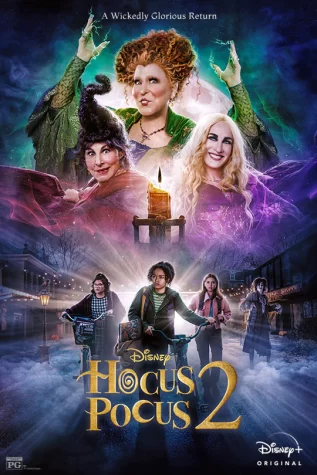HOCUS POCUS 1+2: NEW TIMES, NOSTALGIA, AND VILLAINY
Hocus Pocus 1+2:
Anytime there’s a near 30 year gap between the release of a movie and the release of its sequel, there are bound to be tonal inconsistencies. For one, the criteria for earning a PG rating has changed drastically, meaning Hocus Pocus 1 was able to include scenes and plot elements Hocus Pocus 2 was not allowed to have. Additionally, there’s an added component of self-awareness, often the route studios take when attempting to modernize one of their properties–especially those deemed ‘campy’.

Disney is not unique in the way it chose to handle Hocus Pocus 2. It chose to have its main characters Becca (Whitney Peak) and Izzy (Belissa Escobedo) comment on the strangeness of their situation, and it chose to spend more time on Winifred (Bette Midler), Sarah (Sarah Jessica Parker) and Mary (Kathy Najimy) Sanderson’s back story (the optimistic approach is to say this context develops the characters, the cynical approach is to say it pads the runtime). Hocus Pocus 2 leans into the most beloved scenes of its predecessor, including multiple full-length musical performances, and more screen time for Winifred to yell at her sisters and whatever other character is onscreen.
All of these changes work. Despite being easy to write-off as a Disney cash grab, Hocus Pocus 2 rings less hollow than the attempted revitalization of other properties. It’s enjoyable, it’s engaging, it’s a trip back to a movie a lot of us grew up watching. Part of this is the electricity of the cast, who have all committed to the project 100%, and the other part is the ability of Hocus Pocus 2 to accurately pinpoint what made it so popular in the first place–the Sanderson sisters. Thus, Hocus Pocus 2 is not a service to the studio as much as a service to the audience, a final hurrah for the now-iconic Sanderson sisters and their wickedly witchy ways.
That is the major difference between the two movies, and the source of the greatest tonal dissonance. Hocus Pocus 1 tells the audience of the Sanderson sister’s wickedness, their evil, and shows this to us repeatedly. The movie begins with the death of an adolescent Emily Binx (Amanda Shepherd), and the hanging of the sisters. Their express goal in the movie is to kill as many children as possible to ensure their own immortal beauty.
The second movie more or less pushes this aside, frequently writing off their child-eating as a joke, and validating the behavior of the sisters by showing their childhoods. Hocus Pocus 2 posits Salem’s culpability in the contemporary behavior of the witches. It doesn’t directly show the Salem Witch Trials, but there are more allusions to the event, as well as the power of the town being concentrated in a theocratic leader– Reverend Traske (Tony Hale).
The reason for this decision is two-fold. Principally, the Sanderson sisters, against all moral odds, became the selling point of their franchise. No one dresses up as the heroes of the movie–there are no trick-or-treaters costumed as Max (Omri Katz) or Dani (Thora Birch)–but every year there are trios of little girls dressed as their favorite witch. The much more powerful force at play is a shift in the perception of witches and the way their stories may be told. No longer are witches relegated to be the villains: whether it be the hag or the seductress. Rather, this era of pop-culture is more accepting of the subversion of traditional tropes, and is more interested in the stories of those often villainized.
Therefore, Hocus Pocus 2 is not only an extension of its franchise, but a new Hocus Pocus for a new era.
By and large, these changes work. The Sanderson sisters, if not dynamic characters in the traditional sense, are the most compelling to watch. They are also the least defined of anyone in the movie, giving them both mystique, and leaving it up to the audience to interpret what their actions mean and what their motivations are.
By this metric, the Sanderson sisters give the audience a choice to make: Find a way to validate the Sandersons, or find a way to enjoy their villainy.
Together, Hocus Pocus 1+2 show both sides of this coin.
Hocus Pocus 1 is an unbridled declaration of villainy and enjoying evilness. It’s a movie characterized by eating children, terrorizing children, attempting to find Satan, and wreaking as much havoc as possible.
Hocus Pocus 2 is a more introspective take on the same topics. It’s the reasoning behind why they eat children, terrorize children, want to find Satan, and want to wreak havoc. It attaches their anger and destructive tendencies to wrongdoing in the past, and shows their actions are caused by something external rather than an internal drive to be bad.
In isolation, these ideas are interesting and thought-provoking fare for children’s movies. However, because the two are linked, instead of positioning two different angles, they present one tonally-dissonant one.
It’s impossible to watch Hocus Pocus 2 without thinking about the other one. So while Midler, Parker, and Najimy belt out Blondie’s “One Way or Another,” your mind can’t help thinking about their lack of remorse for killing multiple children.
Ultimately though, it’s up to the audience to decide if these reasons are enough.
Can the Sanderson sisters be redeemed? Were their goals legitimate? Were they justified?
And most importantly: Hocus Pocuses or Hocus Poci?
7/10 would save Salem from destruction again
Further Breakdown:
Writing Quality: 8/10 Enjoyability: 8/10
Pace: 8/10 Visual elements: 9/10
Plot development: 7/10 Insightfulness: 6/10
Characters: 7/10





